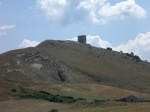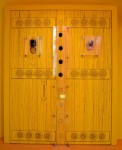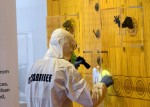Today in people are the worst news, a bronze artifact from the 6th century B.C. has been stolen from an exhibition at the archaeological site of Pompeii. The object was a door ornament on loan from the National Archaeological Museum of Basilicata in Potenza. It’s not of great monetary value. Just 7.3 inches in diameter and relatively plain in decoration, it was insured for 300 euros ($333).
 The piece is of great historical meaning to Basilicata, however, as it was discovered at one of the most important archaeological sites in the region: a hill known as Torre di Satriano where a Norman castle, of which only the tower remains, once dominated the land. Excavations beginning in the 1960s (the first led by pioneer of early Italian archaeology R. Ross Holloway) have discovered evidence of human habitation of the site going back to the second millennium B.C., developing into a complex system of terraced settlements in the 8th century B.C. inhabited by the Peuketiantes, a local people who by the 6th century B.C. were building elaborate multi-use structures influenced by artistic and architectural styles of Greek colonies in Taranto and Corinth. One of the archaeologists who has excavated Torre di Satriano is Massimo Osanna, today the director of the archaeological site of Pompeii.
The piece is of great historical meaning to Basilicata, however, as it was discovered at one of the most important archaeological sites in the region: a hill known as Torre di Satriano where a Norman castle, of which only the tower remains, once dominated the land. Excavations beginning in the 1960s (the first led by pioneer of early Italian archaeology R. Ross Holloway) have discovered evidence of human habitation of the site going back to the second millennium B.C., developing into a complex system of terraced settlements in the 8th century B.C. inhabited by the Peuketiantes, a local people who by the 6th century B.C. were building elaborate multi-use structures influenced by artistic and architectural styles of Greek colonies in Taranto and Corinth. One of the archaeologists who has excavated Torre di Satriano is Massimo Osanna, today the director of the archaeological site of Pompeii.
Massimo Osanna, the director general of the Pompeii archaeological site, expressed dismay. “In addition to being a gesture that injures Pompeii and Italy’s cultural heritage, even though it is not a priceless piece, it hits me on a personal level and it was an area where I had conducted the excavation myself,” he said.
 The bronze stud was an example of that connection between one of the ancient Italic peoples of southern Italy and the colonies of Magna Grecia, which is why it was on display in the Pompeii and the Greeks exhibit in Pompeii’s Palestra Grande (the large gym). One of several bronze ornaments unearthed at the 6th century structure at Torre di Satriano, the wooden door they once adorned had long since decayed. For the exhibition, the stud was set down the middle of a cartoon-like replica of the door with three others just like it, while two larger, highly ornamented bronze knockers were placed on each side, recreating what archaeologists believe was the original placement.
The bronze stud was an example of that connection between one of the ancient Italic peoples of southern Italy and the colonies of Magna Grecia, which is why it was on display in the Pompeii and the Greeks exhibit in Pompeii’s Palestra Grande (the large gym). One of several bronze ornaments unearthed at the 6th century structure at Torre di Satriano, the wooden door they once adorned had long since decayed. For the exhibition, the stud was set down the middle of a cartoon-like replica of the door with three others just like it, while two larger, highly ornamented bronze knockers were placed on each side, recreating what archaeologists believe was the original placement.
The director of the Basilicata Regional Museum Hub, Marta Ragozzino, voiced “solidarity to my friend and colleague Massimo Osanna”.
“Above and beyond its extraordinary Lucanian context, which Osanna himself investigated and which the show on Pompeii and the Greeks has finally unveiled to the public, the stolen relic has modest value,” she said.
“But a gesture of this kind leaves us incredulous and pained, a gesture that attacks and wounds the cultural heritage that belongs to the community and, when brought to Pompeii, the whole world”.
 The theft was discovered by security guards on the evening of Wednesday, May 17th, at around 8:00 PM. That means the stud was stolen during visiting hours, a bold and/or foolhardy choice since the thieves would have had to get behind the protective plexiglass panel in full public view and unscrew the bronze piece from the door-like panel. After hours, the room is under video surveillance. Police are now reviewing the tapes to see if the perpetrators can be identified.
The theft was discovered by security guards on the evening of Wednesday, May 17th, at around 8:00 PM. That means the stud was stolen during visiting hours, a bold and/or foolhardy choice since the thieves would have had to get behind the protective plexiglass panel in full public view and unscrew the bronze piece from the door-like panel. After hours, the room is under video surveillance. Police are now reviewing the tapes to see if the perpetrators can be identified.
There have been rumblings about the quality of the security — the ALES firm has the security contract for the Ministry of Cultural Heritage — for some time. To have an artifact stolen in front of the guards’ noses in broad daylight hasn’t exactly silenced the doubters.